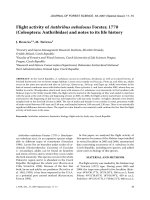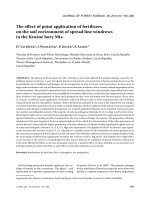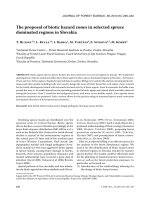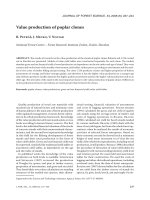Báo cáo lâm nghiệp: "Can sales of infested timber be used to quantify attacks by Ips typographus (Coleoptera, Scolytidae)? A pilot study from Belgium" ppt
Bạn đang xem bản rút gọn của tài liệu. Xem và tải ngay bản đầy đủ của tài liệu tại đây (133.71 KB, 4 trang )
477
Ann. For. Sci. 61 (2004) 477–480
© INRA, EDP Sciences, 2004
DOI: 10.1051/forest:2004041
Original article
Can sales of infested timber be used to quantify attacks
by Ips typographus (Coleoptera, Scolytidae)? A pilot study from Belgium
Anne FRANKLIN
a,b
*, Charles DE CANNIÈRE
a
, Jean-Claude GRÉGOIRE
a
a
Lutte biologique et Écologie spatiale, Université Libre de Bruxelles, 1050 Bruxelles, Belgium
b
Current address: Royal Belgian Institute of Natural Sciences, Dept. Invertebrates, rue Vautier 29, 1000 Bruxelles, Belgium
(Received 16 August 2002; accepted 3 June 2003)
Abstract – Quantifying the abundance and distribution of forest pests is a widespread problem in forest health management. Bark beetles are
monitored using a number of methods, including damage surveys and pheromone trapping. As such methods are expensive and time-
consuming, information is also regularly compiled from estimations of the number of infested trees removed from the forest. The reliability of
those estimations is poorly documented. This pilot study investigated whether data from sales of attacked trees from public forests could be
used for the assessment of Ips typographus infestations in Belgium. Results of the study indicated that local forest officers showed sufficient
expertise in identifying and reporting attacks, but sometimes overestimated attack levels. Despite some limitations, such as the need to avoid
working per flight season or with quantitative estimations of the number attacked trees, sales records can be reliably used to identify stands
infested by I. typographus.
Ips typographus / Scolytidae / attack levels / timber sales / pest management
Résumé – Les ventes de bois infesté peuvent-elles être utilisées pour quantifier les attaques de scolytes ? Une étude de cas en Belgique.
La quantification de l’abondance et de la distribution des ravageurs forestiers est un problème répandu dans le cadre de la gestion de la santé
des forêts. Le suivi des scolytes est effectué à l’aide de différentes méthodes, notamment par l’examen des dégâts et le piégeage par phéromones.
Comme ces méthodes peuvent être onéreuses et lourdes à mettre en œuvre, l’information est aussi souvent obtenue à partir d’estimations
provenant du nombre d’arbres infestés enlevés de la forêt. La fiabilité de des estimations est mal documentée. Cette étude préliminaire a
examiné si les ventes de bois infestés des forêts soumises pouvaient être utilisées pour estimer les niveaux de population d’Ips typographus en
Belgique. Les résultats de l’étude ont montré que les agents forestiers avaient une expertise suffisante pour l’identification et le rapportage des
attaques mais surévaluaient parfois les nombre d’arbres attaqués. Malgré certaines limitations, comme la nécessité d'éviter une comptabilisation
sur base des saisons de vol ou sur base d'estimations quantitatives du nombre d’arbres attaqués, les données des ventes de bois peuvent être
utilisés de manière fiable pour identifier les peuplements attaqués par I. typographus.
Ips typographus / Scolytidae / niveaux d’attaques / vente de bois / gestion des ravageurs
1. INTRODUCTION
There are many different methods for measuring forest pest
populations. In the case of bark beetles, techniques include
damage assessments on individual trees, follow-up of perma-
nent plots, aerial surveys, pheromone trapping of adult insects
or questionnaires sent to foresters [2, 8, 9]. A few countries, like
France and Finland, have made a thorough evaluation of their
monitoring methodology [6, 8] but nearly no information is
available on the quality of statistics compiled from the removal
of infested trees from the forest, even though they are regularly
used to estimate pest status [see references in 4].
One of the most important pests in Belgium is the spruce
bark beetle Ips typographus (Coleoptera, Scolytidae). It can
cause considerable damage to Norway spruce (Picea abies).
Knowledge of population levels is crucial to detect emerging
outbreaks quickly. Some information on attacks by I. typogra-
phus can be obtained from Wallonia’s permanent forest inven-
tory [6], but the collection of data is slow as a full cycle of the
inventory takes 10 years to be completed. An alternative
method is needed for a rapid assessment of infestations. In this
paper, we evaluate whether data from sales of attacked timber
can be used to describe the occurrence of I. typographus in
southern Belgium.
* Corresponding author:
478 A. Franklin et al.
2. MATERIALS AND METHODS
2.1. Data collection
Our project focused on 6 000 ha of public forests in the area of
Saint-Hubert, Wallonia, Belgium. This forest district, which includes
2 500 ha of Norway spruce plantations, suffered heavily from an out-
break of I. typographus in 1991–1992. Information on attacks by the
bark beetle was extracted from timber sales for 1988 to 1996.
In Belgium, timber is sold “standing”. Before being felled, trees are
individually marked and measured in order to have an estimate of their
volume. Each consignment of timber is recorded on a “timber-marking”
form that gives the number of trees per circumference category and
the estimated height of the trees. Other information includes the tree
species, plot location, timber quality and type of felling operation. The
quality of the timber is evaluated using qualitative categories combined
to a quantitative estimation of its commercial value (Tab. I). Only trees
from the same species, quality and felling operation are put in the same
consignment and recorded on a given form.
More than 10 000 sales records were consulted for the 1988–1996
period. About 1 100 forms were selected as corresponding to sales of
trees infested by I. typographus. The selection was made using criteria
such as the tree species, the quality of timber and the silvicultural oper-
ation.
2.2. Data evaluation
In order to test the reliability of the data, an evaluation was carried
out at several levels. First, a questionnaire was submitted to the local
forest officers and was followed by individual interviews in March
1997. Its main purpose was to determine how the officers identified
infested trees and how they reported them on the timber-marking
forms. It was composed of three main sections considering: (a) the
expertise in identifying and recording attacks by I. typographus,
(b) the strategy developed for marking and felling the attacked trees
and (c) the delays that occurred between the identification of attacks
and the removal of infested trees from the forest.
In a second step, the foresters were asked to verify whether the
selected forms for 1993–1996 truly corresponded to infested spruces.
These forms covered a recent, non-epidemic period for which infor-
mation could be retrieved from management diaries or remembered
relatively easily.
Finally, sales records were compared to the actual field situation.
Twenty-five field verifications were made throughout the district between
June 1997 and March 2000. Comparisons checked for the presence and
localisation of infested trees, their number and the year or flight season
they were attacked.
3. RESULTS
The questionnaire was sent to the eleven forest officers wor-
king for the Saint-Hubert forest district. The survey showed that
diagnostic criteria used most frequently to identify attacked
trees (Fig. 1) were resin exudates and the presence of brown
sawdust on the bark or at the foot of the tree (10 of 11 officers).
Resin exudates were also considered by 9 of the 11 officers as
the most important symptom for the identification of an infes-
ted tree. The yellowing of the crown and the bark falling off in
patches were listed by 80% of the officers as very important
symptoms for the identification of attacks. Section two of the
questionnaire revealed that two-third of the foresters regularly
marked a few seemingly healthy trees around infested indivi-
duals, in order to avoid missing an attacked tree without visible
symptoms. All marked trees were felled and sold as infested
timber. Nearly all of those foresters estimated however that
they marked less than 10% of additional healthy trees. The main
finding of the last section of the survey was that most officers
(8 out of 11) felt it was not always possible to spot infested trees
in the same flight season they had been attacked (I. typographus
having two flight seasons per year). All of these estimated that
the proportion of infested trees not identified within the year
of attack was less than 10%; this proportion being no greater
during epidemics than during endemic periods.
Table I. Information provided on the timber-marking forms used by the forest administration in Wallonia. Each form records the characteris-
tics of trees sold in a given timber consignement.
Field Description
Owner Landowner (state, city council, province, etc.)
Locality Name of the place of felling
Compartment Compartment and plot number
Species Tree species
Date Date of the marking of the trees to be felled
Operation Type of felling operation (clearcuts, thinnings, etc.)
Quality Quality of the trees (healthy, dead or dying, windthrows, broken)
Bonus-malus Bonus or penalty given to the trees’ commercial value, depending on their quality, in % of the commercial value
Number Number of trees in each circumference category
Circumference Circumference categories, ranging from 25 cm at breast height (1.50 m in Belgium) to 295 cm (5 cm steps)
Height Average height of the trees in each circumference category (visual estimate)
Comments Any comment the foresters wish to record
Sale Type of sale
Timber sales to quantify attacks by I. typographus 479
During their manual verification of the timber sales for 1993
to 1996, the foresters eliminated about 9% of the selected forms,
which they estimated were not related to sales of infested spru-
ces. Differences in self-confidence were noted between forest
officers, depending on the degree of meticulousness of their
records in their management diaries.
Results from comparisons between written sales records and
the situation in the field are presented in Table II. Trees listed
on the timber-marking forms were always correctly located by
compartment number but there were some inaccuracies in plot
locations within compartments, for example when plot num-
bers were forgotten. In 23 of the 25 sites, all beetle-marked trees
were attacked by I. typographus. The two exceptions concer-
ned trees thought to be infested by the beetle though they
actually were healthy (wrongly recorded on the form) and attac-
ked trees missed in an outbreak area (forgotten on the form).
Divergences were more important as far as the number of attac-
ked trees were concerned: about one third of the forms listed
more infested trees than there really were. When the date of
marking was compared to the stage of the attacks, it was obser-
ved that trees were often marked only when attacks became
detectable from a distance, when the bark started falling from
the tree or when the crown turned yellow. Nine (36%) of the
visited sites hosted trees that had been attacked during the pre-
vious flight season – the beetles had already flown away – and
in 4 (16%) of the sites, trees had been attacked a year or more
earlier (Tab. II).
4. DISCUSSION
The questionnaire, interviews and field verifications yielded
important information concerning the way damage levels were
assessed by the forest officers. The survey showed that resin
exudates were considered to be the most important factor for
the identification of I. typographus infestations. Following
interviews, it appeared that, if most foresters used several symp-
toms to identify attacked trees, some of them marked trees
without any other symptom than resin exudates. The presence
of resin exudates, however, is not particularly correlated with
I. typographus attacks. It is not even specific to bark beetles,
as trees can emit resin as a defence reaction to numerous factors
such as insects, fungi, environmental stress and harvesting inju-
ries [3]. Such incorrect diagnosis habits lead to the overestima-
tion of I. typographus damage levels. Other diagnosis criteria
regularly used by the officers (Fig. 1) proved to be appropriate
for the correct identification of infestations. The overestimation
of attacks was further increased by the tendency of some offi-
cers to mark a greater number of trees than necessary. The main
reason evoked was security: they preferred to deploy a sanitary
boundary around the infestation in case some trees did not yet
bear visible symptoms. On the other hand, foresters admitted
that some trees remained undetected up to one year (or more)
after their attack. Several reasons were given for this lack of
detection, such as greater spotting difficulties in dense spruce
plantations or in plots with low accessibility. The scarcity of
clearly visible symptoms during early infestation stages also
delayed detection of damage.
The verification procedure of the sales records has to be
interpreted cautiously, as the questionnaire and interviews
demonstrated that foresters could make mistakes in the identi-
fication of infestations. This would be reflected further in their
assessment of recorded data. Moreover, some officers were less
careful than others in recording observations of attacks in their
management diaries and could be unsure in the comparison of
their notes to the selected forms. However, the verification proce-
dure usefully highlighted that pre-selected forms corresponding
to consignments of small diameter trees, and with no specific
comments relating to I. typographus attacks, were often related
to trees dying of competition in young plantations or to trees
attacked by another bark beetle, Pityogenes chalcographus.
As stated by Anderbrant [1], a good monitoring system
should be able to answer three questions about the target spe-
cies: “where does it occur?”, “when does it occur?” and “how
many insects are there?”. This study shows promising possibilities
for the use of records from sales of infested timber, at least
regarding the first two questions. Information seems to be reli-
able if summarised per compartment and per year, but not per
flight season. However, sales records do not answer the third
question. In this study, the attack levels are overestimated,
Table II. Comparison of records on timber-marking forms with the situation in the field. Field assessments (N = 25 sampled sites) checked
whether the forms correctly recorded the presence of trees attacked by I. typographus, the number of infested trees, the year and the flight
season the trees were attacked.
Presence Number of trees Year Flight season
Number of correct forms 23 (92%) 17 (68%) 21 (84%) 16 (64%)
Number of forms with errors 2 (8%) 8 (32%) 4 (16%) 9 (36%)
Figure 1. Diagnosis strategies. The bar chart shows the frequency at
which particular features were mentioned by the forest officers. The
line graph shows the number of times that a criterion was mentioned
as one of the three most important identification clues: (1) resin exu-
dates; (2) brown sawdust on bark/at foot of tree; (3) entrance/exit
holes; (4) yellow/dead crown; (5) galleries under the bark; (6) bark
falling off in patches; (7) dead branches and twigs; (8) yellow shoots
and needles; (9) presence of fungi; (10) other. N = 11 forest officers.
480 A. Franklin et al.
as more trees are cut than are actually infested. The reliability
of data could probably be improved if standard rules for record-
ing infestations are established. Foresters could also be trained
to use appropriate symptoms for the identification of attacks
and encouraged not to mark more trees than necessary. A good
step has been achieved in this direction, as recording proce-
dures in Wallonia have been changed since the study was car-
ried out. A specific codification is now applied to trees attacked
by bark beetles, allowing them to be differentiated unequivo-
cally on the sales records from windthrows or from other dead
timber.
Due to its restricted geographical scale, the assessment of
forest sales statistics carried out in this study is only valid
locally. However, an extension of the study could be carried out
relatively easily and would prove extremely useful, not only to
scientists but to forest managers as well.
Providing that limitations are clearly established, sales of
infested timber could provide a rapid and cost-effective way to
estimate past and current infestations. The approach should
ideally be complemented by more detailed information from
monitoring with pheromone traps or from permanent plot stu-
dies. Experience from national inventories has shown that the
most important abiotic or biotic epidemics could be uncovered
in this way [5, 7].
Acknowledgements: The authors wish to thank Ir. Cl. Charue and
the forest officers at Saint-Hubert for their enthusiastic collaboration
to the project. Funding for this work was provided by a F.R.I.A.
research grant to Anne Franklin. J C. Grégoire thanks the FNRS for
financial support.
REFERENCES
[1] Anderbrant O., Monitoring pine sawflies with pheromone traps, in:
Grodzki W., Knízek M., Forster B. (Eds.), Methodology of forest
insect and disease survey in Central Europe, Proceedings of the
First Workshop of the IUFRO WP 7.03.10, April 21–24 1998,
Ustron-Jaszowiec, Poland, Warszawa, Forest Research Institute
(IBL), 1998, pp. 75–79.
[2] Berryman A.A., Population dynamics of the fir engraver, Scolytus
ventralis (Coleoptera: Scolytidae). I. Analysis of population beha-
vior and survival from 1964 to 1971, Can. Entomol. 105 (1973)
1465–1488.
[3] Christiansen E., Waring R.H., Berryman A.A., Resistance of coni-
fers to bark beetle attack: searching for general relationships, For.
Ecol. Manage. 22 (1987) 89–106.
[4] Forster B., Knizek M., Grodzki W. (Eds.), Methodology of forest
insect and disease survey in Central Europe, Proceedings of the
Second Workshop of the IUFRO WP 7.03.10, April 20–23, 1999,
Sion-Châteauneuf, Switzerland, Birmensdorf, Swiss Federal Insti-
tute for Forest, Snow and Landscape Research (WSL), 1999.
[5] Landmann G., Nageleisen L M., Flot J L., Forest health monito-
ring on permanent plots considered in combination with forest
insect and disease survey results: the French experience, in: Forster
B., Knizek M., Grodzki W. (Eds.), Methodology of forest insect
and disease survey in Central Europe, Proceedings of the Second
Workshop of the IUFRO WP 7.03.10, April 20–23, 1999, Sion-
Châteauneuf, Switzerland, Birmensdorf, Swiss Federal Institute for
Forest, Snow and Landscape Research (WSL), 1999, pp. 67–73.
[6] Lecomte H. , Florkin P., Thirion M., L’inventaire des massifs fores-
tiers de la Wallonie: aperçu global de la situation en 1996, Fiche
technique no. 9, Ministère de la Région Wallonne, Direction Générale
des Ressources naturelles et de l’Environnement, Namur, 1997.
[7] Nevalainen S., Nationwide forest damage surveys in Finland, in:
Forster B., Knizek M., Grodzki W. (Eds.), Methodology of forest
insect and disease survey in Central Europe, Proceedings of the
Second Workshop of the IUFRO WP 7.03.10, April 20–23, 1999,
Sion-Châteauneuf, Switzerland, Birmensdorf, Swiss Federal Institute
for Forest, Snow and Landscape Research (WSL), 1999, pp. 24–29.
[8] Thatcher R.C., Mason G.N., Hertel G.D., Searcy J.L., Detecting
and controlling the southern pine beetle, Southern J. Appl. Forestry,
6 (1982) 153–159.
[9] Worrel R., Damage by the spruce bark beetle in South Norway
1970–1980: A survey, and factors affecting its occurrence, Med.
Nor. Inst. Skogforsk. 38 (1983) 1–34.
To access this journal online:
www.edpsciences.org









